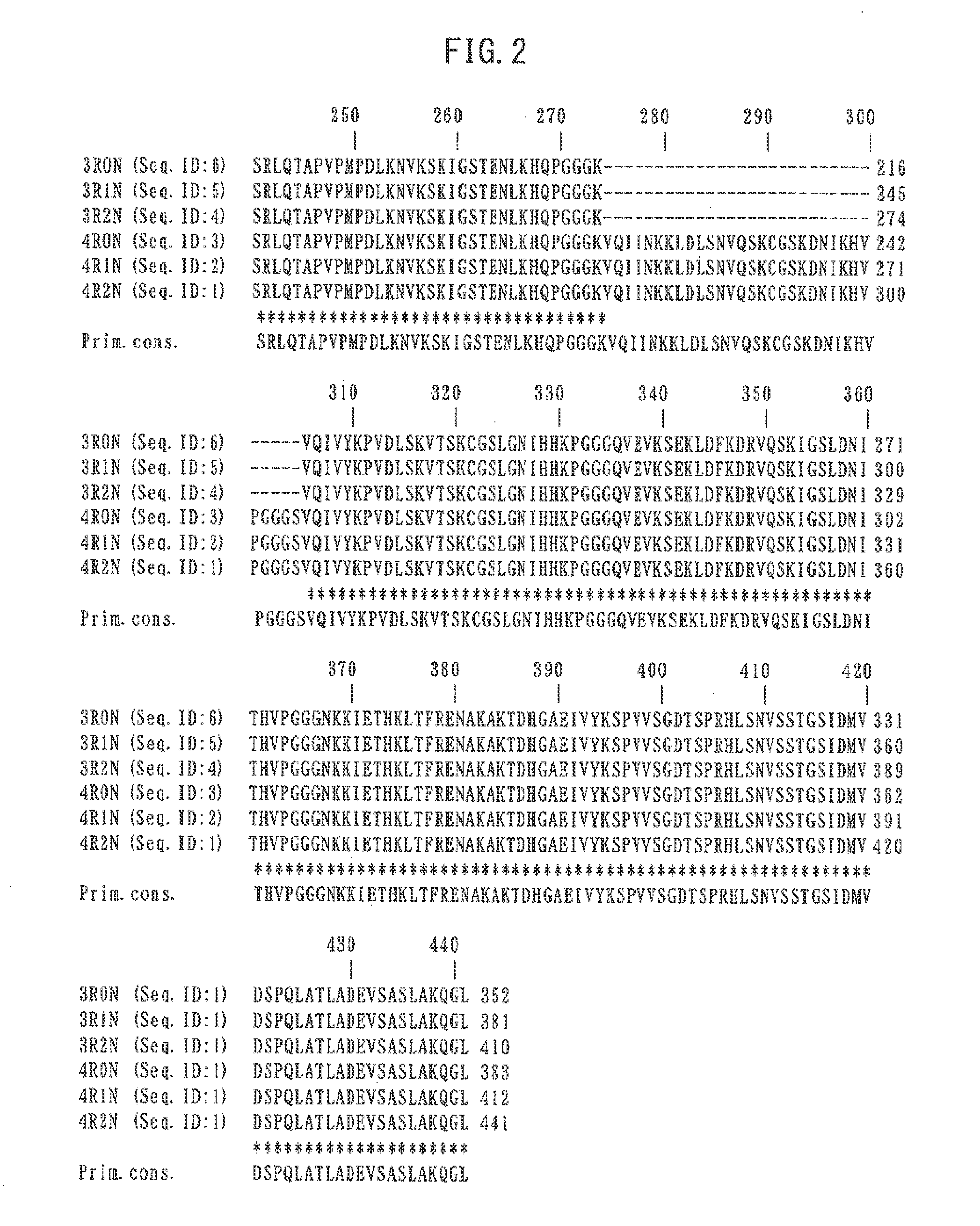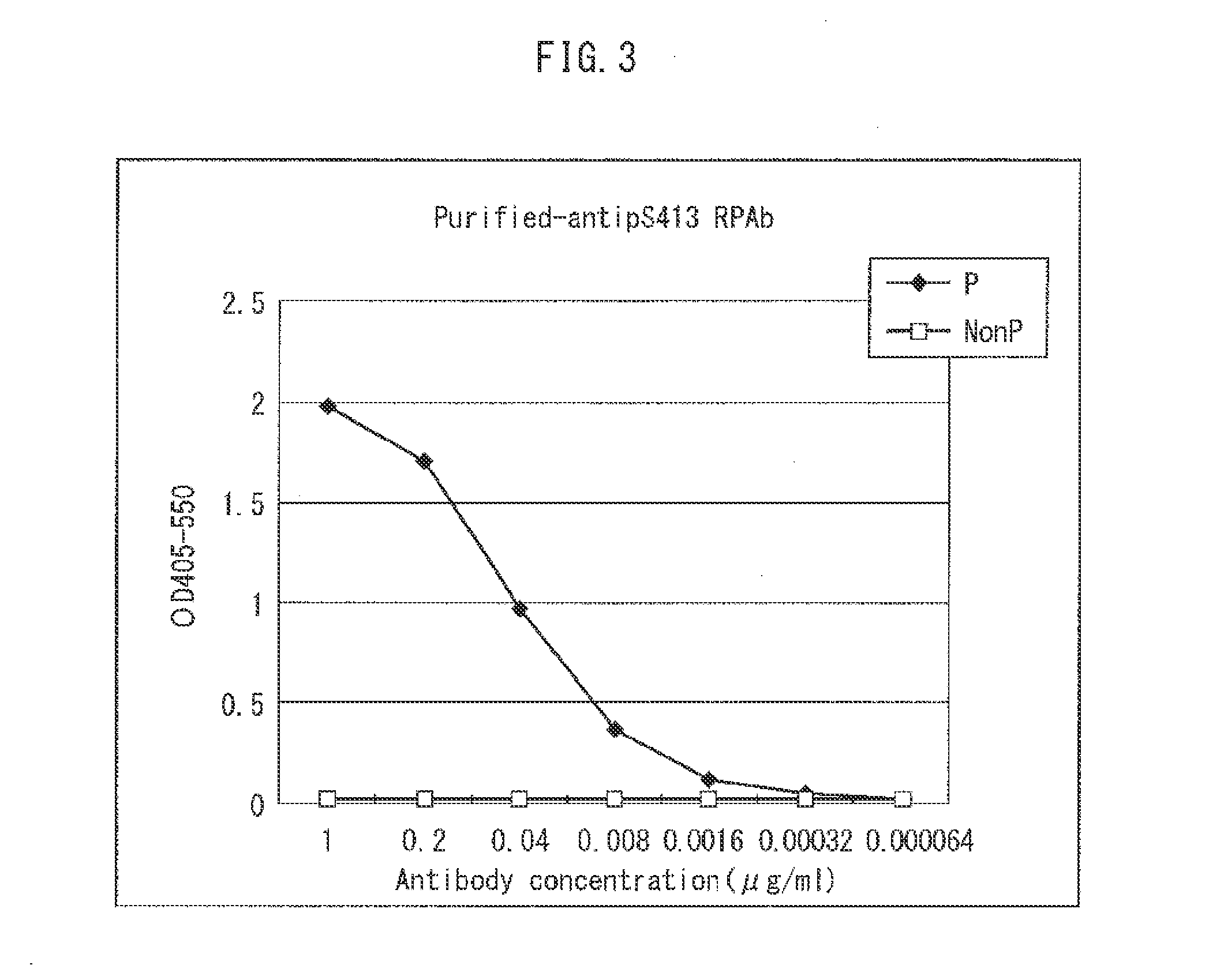Therapeutic agent or prophylactic agent for dementia
a cognitive disorder and prophylactic agent technology, applied in the direction of antibody medical ingredients, drug compositions, peptide sources, etc., can solve the problems of further modification, difficult selection of epitopes, side effects, etc., and achieve the effect of improving cognitive function and high cognitive function
- Summary
- Abstract
- Description
- Claims
- Application Information
AI Technical Summary
Benefits of technology
Problems solved by technology
Method used
Image
Examples
example 1
Preparation of Rabbit Polyclonal Antibody for pSer413 Peptide
[0118]The antigen used to prepare antibody for pSer413 peptide was a synthetic peptide (SEQ ID NO: 31, synthesized by Medical & Biological Laboratories Co., Ltd. [MBL]) having Cys attached at the C-terminal site of the amino acid sequence corresponding to the region from the 410th Asn to the 416th Ser of the amino acid sequence of SEQ ID NO: 1 for human tau protein, phosphorylated at Ser corresponding to position 413 (this peptide will hereunder be referred to as pSer413(S) peptide).
pSer413(S) Peptide: N-AsnValSer(pSer)ThrGlySerCys-C(SEQ ID NO: 31)
[0119]Following synthesis, the pSer413(S) peptide was purified with HPLC and covalently bonded with KLH (Keyhole Limpet Hemocyanin). The obtained conjugate was used for immunization with 0.1 mg per dose per rabbit. For the first immunization, 0.2 mL of conjugate solution (conjugate concentration: 0.5 mg / mL) was mixed with an equal amount of Freund's complete adjuvant, and the dor...
example 2
Preparation of Monoclonal Antibody for pSer413 peptide (Ta15 Series)
[0123]The antigen used was synthetic peptide pSer413(Im) (SEQ ID NO: 35), having GlyCysSerGly attached at the N-terminus of the sequence corresponding to the region from the 403rd Thr to the 423rd Pro, phosphorylated on the amino acid residue corresponding to Ser at position 413 of the amino acid sequence of human tau protein represented by SEQ ID NO: 1. Following synthesis, the pSer413(Im) peptide was purified with HPLC and covalently bonded with KLH (Keyhole Limpet Hemocyanin). The obtained conjugate was used for immunization with 0.04 mg per dose per mouse. The immunization was conducted by intraperitoneal injection into 10 mice at 200 μL each of a mixture of 0.4 ml of conjugate solution (1.1 mg / ml in terms of peptide), 0.7 mL of saline and 1.1 mL of Freund's complete adjuvant. Three more similar immunizations (with the same immunization location and antigen dose, using Freund's incomplete adjuvant) were conducte...
example 3
Measurement of Ta15 Series Antibody Binding Affinity
[0131]In order to evaluate the binding affinity between the Ta15 Series antibodies and antigen peptide (pSer413 peptide (Im): see Example 2), a Biacore Surface Plasmon Resonance (SPR) system (BIACORE3000, code# BR-1100-45, by GE Healthcare, Japan) and each Biacore product were used for measurement according to the manufacturer's manual. One method of measurement used was a method of immobilizing (code# BR-1006-33) anti-mouse antibody (code# BR-1008-38) on a CM5 chip (carboxymethyldextran layer-formed chip, code# BR-1100-14) by covalent bonding through amine coupling reaction, binding the Ta15 Series antibody to the immobilized anti-mouse antibody, and measuring the binding behavior of the antigen peptide to the bound Ta15 Series antibody.
[0132]The specifically-binding reaction mixture was used with HBS-EP buffer (code# BR-T-1001-88), and the CM5 chip was activated by a mixed solution of N-ethyl-N′-(3-dimethylaminopropyl)-carbodiimi...
PUM
| Property | Measurement | Unit |
|---|---|---|
| equilibrium dissociation constant | aaaaa | aaaaa |
| equilibrium dissociation constant | aaaaa | aaaaa |
| equilibrium dissociation constant | aaaaa | aaaaa |
Abstract
Description
Claims
Application Information
 Login to View More
Login to View More - R&D
- Intellectual Property
- Life Sciences
- Materials
- Tech Scout
- Unparalleled Data Quality
- Higher Quality Content
- 60% Fewer Hallucinations
Browse by: Latest US Patents, China's latest patents, Technical Efficacy Thesaurus, Application Domain, Technology Topic, Popular Technical Reports.
© 2025 PatSnap. All rights reserved.Legal|Privacy policy|Modern Slavery Act Transparency Statement|Sitemap|About US| Contact US: help@patsnap.com



